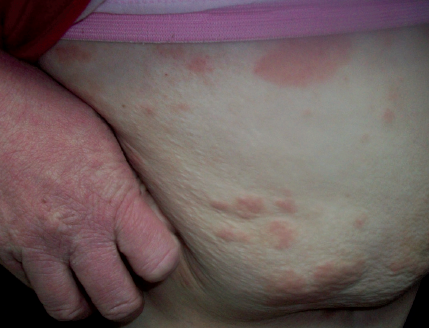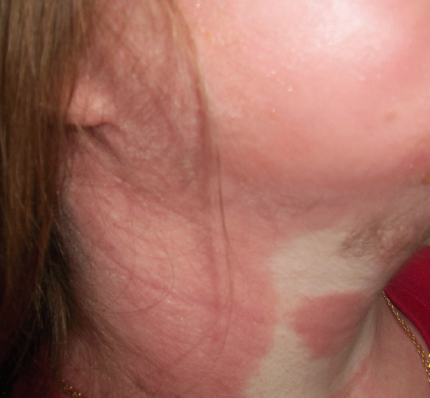Atopic Dermatitis
An 18-year-old female presented with skin lesions across her entire body. She complained of itchy, red skin patches with no known triggers. The flaking of her skin and nasal allergies were also worsening.
Upon physical examination, red, scaly areas with excoriation were found on the trunk, neck, and extremities (Figures 1-4). There was no pus or discharge. She also had dry skin across her body with some cracking along the wrists and hands.

Figure 1. Bilateral forearm and wrist rashes.
After being given prednisone and triamcinolone steroid cream, her condition had significantly improved by the next visit—although some mild, dry scaly patches along the extremities and trunk remained. Percutaneous skin testing revealed allergies to strawberries, tomatoes, egg, peanut, wheat, fish, milk, soy, shrimp, sesame seed, corn, and multiple inhalants. Complete blood count was normal except for eosinophilia. Total IgE levels was elevated at 6277.
The patient was diagnosed with severe atopic dermatitis and treated with topical steroid creams, daily moisturizers, food allergen avoidance, and antihistamines.

Figure 2. Back rash.
Discussion. Atopic dermatitis, also known as eczema, is often the first manifestation of allergies and the first disease process in the allergic triad, which can progress to allergic rhinitis and asthma. Eighty percent of eczema cases appear before the age of 5, but the disease can still emerge in adults.1 In eczema, skin barrier function is diminished as a result of the loss of essential lipids, causing dry skin.2
Eczema in children has the characteristics of pruritus and dermatitis in the face, neck, and extremities.3 Acute skin lesions are most often found in infants and young children, distinguished by severely itchy, erythematous, papulovesicular lesions accompanying serous exudate and excoriation.4 Chronic atopic dermatitis is distinguished by lichenification, papules, and excoriation.4 In adults, the rashes occur mainly in the folds of the extremities. Severe itching, pruritus, and relapsing eczematous lesions are key indicators of atopic dermatitis.3

Figure 3. Abdominal and right hand rashes.
Serum IgE levels are very elevated in patients suffering from atopic dermatitis. Determining the severity of the eczema is crucial in order to properly manage symptoms. Triggers that worsen atopic dermatitis need to be identified and avoided; common triggers include allergens, stress, temperature, humidity, and irritants.
Allergens can be discovered by either skin testing or in vitro testing for IgE antibodies.4 All patients require hydration of the skin followed by an emollient to preserve moisture levels.5

Figure 4. Right face and neck rashes.
Atopic dermatitis is a chronic condition with frequent relapses, resulting in most patients having only a partial response to treatment. Therefore, treatment needs to be individualized and altered based on the patient’s current level of severity.4 ■
References:
1. Bieber T, Leung DY, eds. Atopic Dermatitis. New York, NY: Marcel Dekker Inc; 2002.
2. Imokawa G. Lipid abnormalities in atopic dermatitis. J Am Acad Dermatol. 2001;45(Suppl):S29-S32.
3. Hoare C, Li Wan Po A, Williams H. Systematic review of treatments for atopic eczema. Health Technol Assess. 2000;4:1-191.
4. Leung DY, Nicklas RA, Li JT, et. al. Disease management of atopic dermatitis: an updated practice parameter. Ann Allergy Asthma Immunol. 2004;93:S1-S21.
5. Andersson AC, Lindberg M, Loden M. The effect of two urea-containing creams on dry eczematous skin in atopic patients, I: expert, patient and instrumental evaluation. J Dermatol Treat. 1999;10:165:169.


